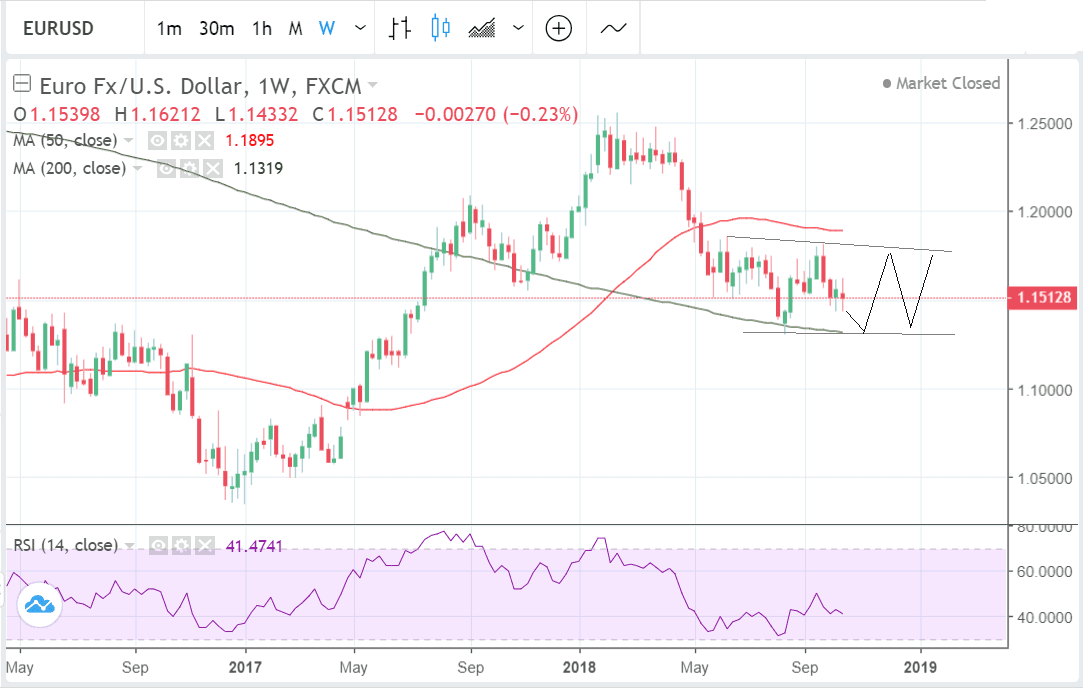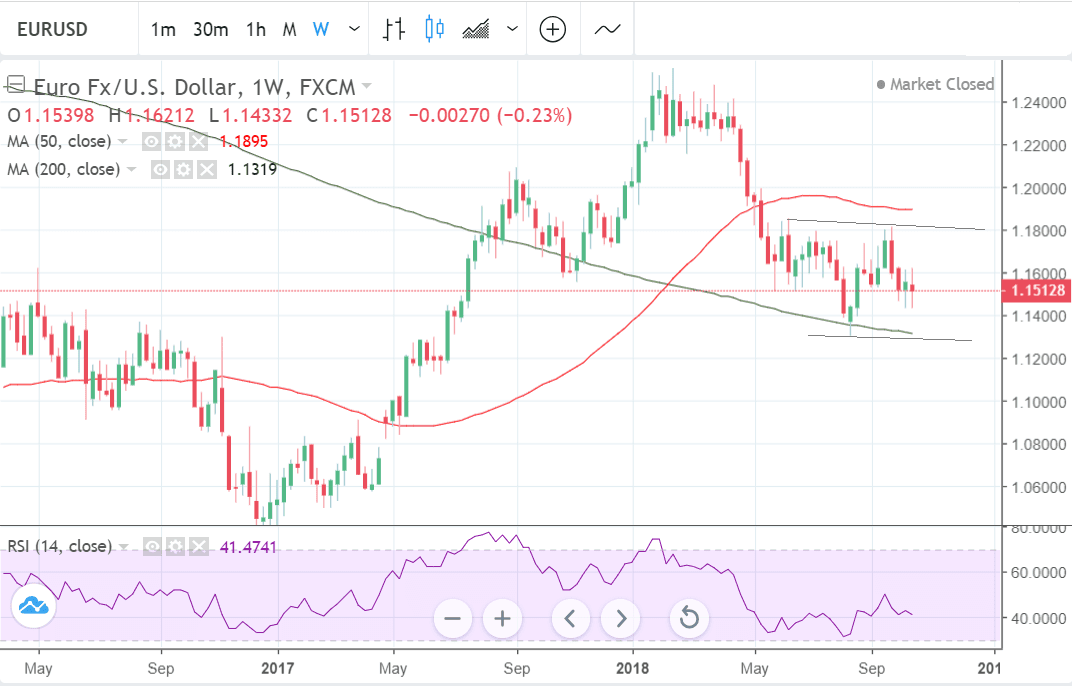Euro-to-Dollar X-Rate in the Week Ahead: Rising Within Confined Range

Image © Adobe Images
- EUR/USD could rise within its range
- A break above the 1.16s would confirm
- The Euro's main event is the ECB policy meeting + Italian budget saga
- GDP data is key for the US Dollar
EUR/USD remains rangebound, like many Dollar pairs, and has been trading roughly between 1.1300 and 1.1800 since the beginning of May.
We see this rangebound behaviour extending during the week ahead, with a mild bias to upside within the range provided political uncertainty relating to Italy doesn't flare-up and prompt unexpected moves in the market.
The range roughly corresponds to the locations of the 50 and 200-week moving averages as can be seen on the chart below. These often provide natural barriers to price-action as they attract higher numbers of buyers and sellers looking to fade the dominant trend.
The recent recovery from the August lows was accompanied by strong momentum, as measured by the RSI indicator in the lower panel. This suggests bullish confidence and increases the chances of more upside.
The price action looked at on the daily timeframe below, suggests, the pair is more likely to rise within the range rather than fall. A rally would provide a better fit with the course of previous price action. We expect a break above the 1.1621 highs to confirm an extension up to a target at 1.1765 close to the ceiling, at the R1 monthly pivot.
A break back down to the 1.1300 lows, is also possible and would be confirmed by a break below Friday's 1.1433 lows, however, on balance, we retain a marginally bullish base-case scenario of more upside.
Advertisement
Bank-beating EUR/USD exchange rates: Get up to 5% more foreign exchange for international payments by using a specialist provider to get closer to the real market rate and avoid the gaping spreads charged by your bank when providing currency. Learn more here
The Euro: What to Watch this Week
The main event for the Euro is probably policy meeting of the European Central Bank (ECB) on Thursday, October 25.
Although no change in policy is forecast the market will be scrutinising the accompanying statement and president Draghi's comments for signs of future policy direction.
The current stance remains for the ECB to end quantitative easing at the end of 2018 and to start raising interest rates in September 2019, any deviation from these two parameters will probably affect the Euro. If they are brought forward the Euro will appreciate if pushed back the single currency will decline.
Currently, the consensus appears marginally biased to the more negative assessment.
"The Eurozone’s economy has been unable to regain steam after a notable slowdown at the start of 2018. The ECB has insisted the region’s fundamentals remain strong as it readies to conclude its asset purchase program at the end of December. However, investors are more skeptical about the growth outlook and this cautiousness is one of the reasons why many analysts are bearish on the single currency for the next few months," says broker XM.com.
The other main driver for the Euro in the coming week will be the ongoing Italian budget saga.
The E.U. Commission (EC) last week responded to Italy's budget plans, giving the government until Monday to explain its “obvious significant deviation” from the E.U.’s rules. This and a steady newsflow covering the matter ensured the cost of servicing Italian debt shot sharply higher towards the end of the week as markets grew increasingly nervous over the prospect of a Eurozone schism.
The budget set by Italy's coalition government currently breaches the E.U.'s Stability and Growth Pact which requires Eurozone states to respect limits for budget deficits and public debt of 3% and 60% of GDP, respectively.
In a step that could prepare the ground for an unprecedented rejection of a member state’s fiscal plan, the EC last week sent a letter to Italy saying the country’s 2019 budget plans are unprecendented by Eurozone standards.
We expect further developments to be watched by an increasingly nervous market over coming days.
"It could be a matter of time before the Euro falls through the bottom of its range after the EU signaled a thumbs down to Rome’s budget for the coming year," says Joe Manimbo, a foreign exchange strategist with Western Union.
The other main release for the Euro in the coming week are manufacturing and service sector PMIs, which are survey-based gauges of purchasing manager sentiment within key industry sectors.
The Manufacturing PMI in October is expected to slow to 53.1 from 53.2 in September; the Services PMI is forecast to 54.5 from 54.7 and the combined composite to fall to 53.9 from 54.1. A result above 50 signifies expansion; below contraction.
The U.S. Dollar: What to Watch this Week
The main release for the US Dollar in the week ahead is Q3 GDP data out on Friday at 13.30 B.S.T, which is forecast to show a 3.3% rise compared to the previous quarter.
This will be lower than the strong 4.2% result in Q2 but still above trend. Economists think there will be a decline because Q3 data will not benefit from exporters - such as those of soybeans - upping their volumes before the imposition of tariffs in August.
"Growth is forecast to have moderated to 3.3% in the third quarter, which still represents above-trend growth for the US economy. The Dollar, which against a basket of currencies has been consolidating since mid-August, could resume its uptrend if there is an upside surprise to the GDP figures," says broker XM.com.
October Manufacturing sector PMI data is forecast to show a slight down-tick to 55.5 from 55.6 when it is released on Wednesday at 14.45, Services, however, is expected to have risen to 54.1 from 53.5.
PMIs are survey-based gauges which have been found to be relatively accurate leading indicators for growth; a result over 50 represents expansion and below 50 contraction.
Durable goods orders is a key release on Thursday, at 13.30. It is forecast to show a -1.3% drop compared to the previous month, mainly because that result was so high due to the outsized 70% contribution from the aircraft component.
This explains why core durable goods orders are expected to show a rise of 0.3% in September - because it strips out the volatile aircraft component.
Other data on Thursday includes Pending Home Sales out at 15.00, which is forecast to show a -0.2% fall in September month-on-month in line with the recent sluggish trend in housing data.
New Home Sales are out on Wednesday at 15.00 and expected to show a -1.4% slowdown in September compared to August.
Tuesday is a busy day for commentary from policymakers at the US Federal Reserve with Kashkari set to speak at 14.30, and Bostic at 18.30.
Advertisement
Bank-beating EUR/USD exchange rates: Get up to 5% more foreign exchange for international payments by using a specialist provider to get closer to the real market rate and avoid the gaping spreads charged by your bank when providing currency. Learn more here






